
SUNSCAPES: Images of Our Magnetic Star
An on-line overview of the
exhibition that was shown in the
National Academy of Sciences
(February 19, 2002 -- August 15, 2002)

An on-line overview of the
exhibition that was shown in the
National Academy of Sciences
(February 19, 2002 -- August 15, 2002)
Our magnetic Sun
Most people do not give the Sun, the nearest of all stars, a second thought. Neither its presence nor its apparent stability are questioned. If we did, it would quickly become clear that the Sun is a star whose variability affects us in many ways. It appears to modulate Earth's climate, with effects that are yet to be fully understood; it also impacts our technology, as eruptions on the Sun interrupt communications, affect navigation systems, generate radiation that may be harmful to astronauts and airline passengers, and occasionally push power grids to failure. The cause of this variability is the Sun's magnetic field.
The magnetic field of the Sun shapes its atmosphere from the surface to well beyond the orbit of the Earth. It heats the atmospheric gases to temperatures that are nearly a thousand times higher than the temperature of the visible surface. The atmosphere of the Sun glows at many different colors (wavelengths), depending on the temperature of the gas. Those colors (or wavelengths) visible to our eyes are formed near the surface, where temperatures lie around 10,000º F (5850 K). High above the Sun's surface, the gas is much hotter with temperatures up to 10,000,000º F. This gas glows in the extreme ultraviolet range and in X-rays. Light from regions of higher temperature does not penetrate the Earth's atmosphere, and can only be observed by telescopes in the vacuum of space. Special optical systems and detectors are used to image this mysteriously glowing Sun, with "false" colors added, giving visual form to things our unaided eyes could never see. This exhibition shows close ups of an unfamiliar Sun at colors that range from the visible, through the ultraviolet, to the X-ray part of the spectrum of light.
The Magnetic Field of the Sun
The magnetic field of the sun is created by a process that we call the dynamo. The functioning of the dynamo in the Sun (and in other stars like it) is one the greatest mysteries in astrophysics. Currently our understanding of stellar dynamos is too limited to be useful for the forecasting of the Sun's activity on the time scales of days to decades or centuries. Historical records show that the Sun significantly changes its magnetic activity on all of these time scales. When activity decreases, the Sun dims slightly. When this happened in the 17th Century, it caused the Little Ice Age. Increased activity – such as apparently happened during the medieval Grand Maximum – may cause a warm spell. Increased activity is associated with more frequent space storms as well as heightened ultraviolet radiation that is harmful to life on Earth.
Observed in ultraviolet and X-ray light, the Sun is nothing like the featureless sphere that appears to the naked eye. Magnetic fields structure and guide hot, translucent clouds upward from the surface. The changing magnetic fields cause electrical storms to make the outer atmosphere a thousand times hotter than the surface – sometimes even more.
The hot gases are generally constrained to move with the magnetic fields, resulting in spectacular but oddly unfamiliar Sunscapes. During giant explosions, this gas, the field that permeates it, and particles accelerated to near light speed can be expelled from the Sun, and – if thrown into our direction – can temporarily envelop the Earth to cause space weather.
New instruments, both in space and on the Earth, are revealing the beauty of the Sun, as well as the physical processes that underlie its variability. These new observatories, together with experiments on state-of-the-art supercomputers, have started an ongoing revolution in the understanding of our Sun, the nearest of all stars. New methods of observation even allow us to image the interior of the Sun: acoustic imaging techniques, using ever present Sun-quakes, are beginning to show us the source of the Sun's magnetic heartbeat. Together, the multi-faceted, international efforts of solar physicists are beginning to reveal some of the deepest secrets of the Sun.
Sample images from the exhibition:
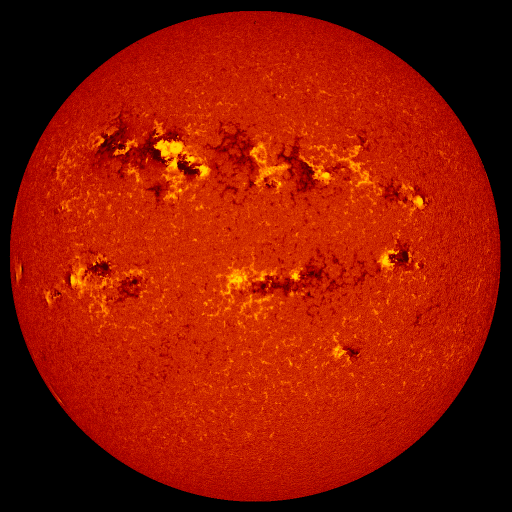
When light emitted by some chemical elements and at particular wavelengths travels through a magnetic field it becomes polarized. Special telescopes can measure that polarization and thus map the magnetic field at the Sun's surface in detail. This map, recorded in light emitted by iron ions, shows the regions of opposite magnetic polarity in different colors.
The magnetic field is generated deep within the Sun's interior by a process referred to as the dynamo. Although poorly understood at present, the Sun's dynamo is driven by the coupling of differential solar rotation and the seething convective motions that occur in the outermost 30% of the Sun. The dynamo in the Sun, as in all other Sun-like stars, generates magnetic field that in part floats to the surface. Magnetic regions of all sizes pop up without much preference for a particular location, as long as it is not too close to the poles. The strongest fields, in so-called active regions, cluster in fairly narrow belts around the Sun on either side of the equator.
This magnetic map was recorded with the Michelson Doppler Imager onboard the ESA/NASA Solar and Heliospheric Observatory.
The Sun's hot atmosphere: the corona.
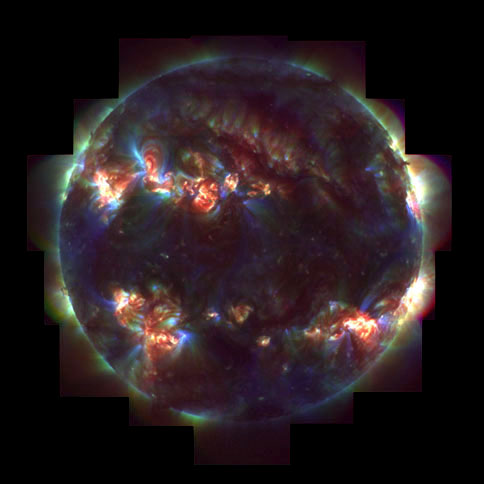
The hot solar outer atmosphere that we call the corona is spectacularly beautiful when seen at high resolution. Such a resolution can at present be provided only by the Transition Region and Coronal Explorer, TRACE. Each of its exposures shows only part of the entire Sun. To show it all, this mosaic was made. It comprises exposures that image three different temperature regimes at each of 23 positions, carefully put together to form a full-Sun image.
This false-color image shows emission from gas at 2, 3, and 4 million degrees Fahrenheit: the dim blue is coolest, the bright red and white hottest. The extreme ultraviolet light recorded by the TRACE camera is emitted by a gas of ionized iron that is caught in the Sun's magnetic field. Wherever the gas is hot and dense enough, segments of the magnetic field lines are outlined forming so-called coronal loops. Many loops contribute to the total brightness along any line of sight, because the solar atmosphere is completely transparent for this light. The solar corona envelops the entire Sun, which is seen as a dark sphere in this composite image because its surface emits no extreme ultraviolet light.
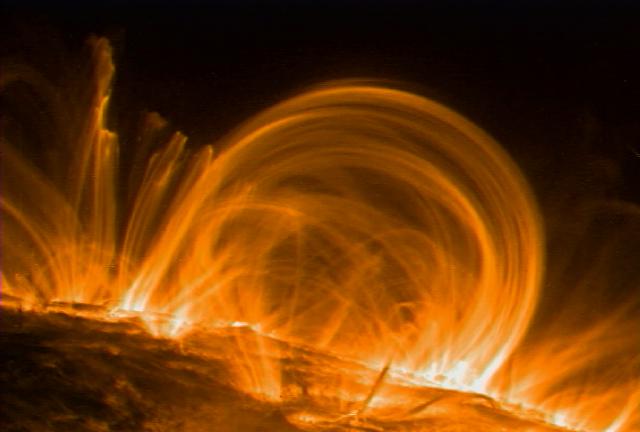
This image of a magnetically active region at the edge of the Sun shows "loops" that connect one magnetic polarity to the other. The heating that is associated with the magnetic field warms gas at the base of the loops to a temperature of a million degrees or more. This causes it to "evaporate" into the high regions of the atmosphere, where it is supported by the associated gas pressure against the Sun's gravitational pull.
The image was taken by the Transition Region and Coronal Explorer.
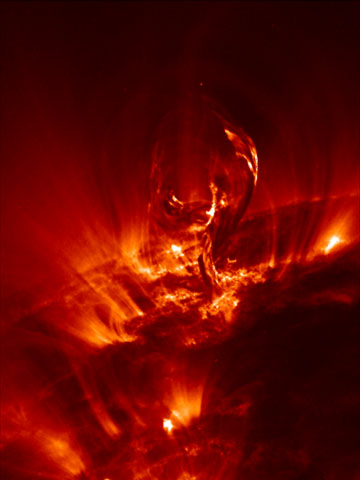
Large eruptive and explosive events, or coronal mass ejections, (CME) occur infrequently and irregularly, even at the maximum of solar magnetic activity. In filament eruptions, such as the one pictured above, relatively dense material of some 10,000 º F lifts rapidly from just above the solar surface, caught in the stretching, twisted magnetic field. Where the gas is hot (about 2 million degrees) it glows brightly in the extreme ultraviolet light (Fe IX/X). Wherever the temperature is below approximately 20,000 degrees and the gas relatively dense, it absorbs the light emitted by hot gas behind it, resulting in dark strands and blobs.
In a CME, a total mass as large as that of the Mississippi can be ejected into space at speeds of hundreds of miles per second. Most of those erupting rivers of gas do not manage to escape the Sun's gravitational pull, however, and fall back to the surface.
Image taken by the Transition Region and Coronal Explorer.
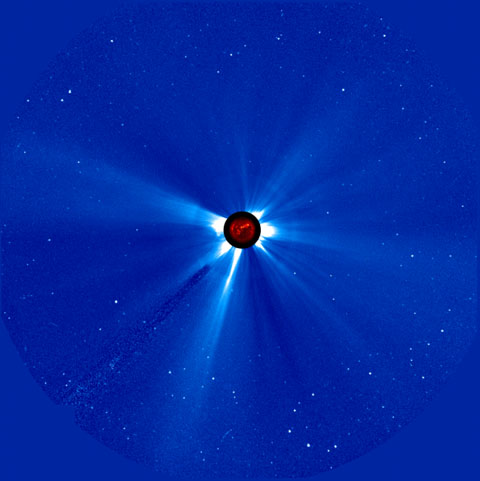
With the bright light of the Sun blocked out by an occulting disk in the LASCO telescope on SOHO, a faint glow is seen against the starry background sky of 8 February 2001. The light that we see is sunlight scattered off the material in the solar wind, thus creating a faint haze whose brightness reflects the density of the material. This glow reveals the solar wind that consists of adjacent streams of tenuous gas moving away from the Sun at speeds that range for two to six hundred miles per second.
The red central image is an X-ray image of the Sun, observed by the Japanese-American YOHKOH satellite. Wherever the magnetic field is strong, the corona is bright. Above regions where the field at the surface is strong, a relatively dense, "slow wind" is formed. Where the field at the surface is weak, field lines may open into interplanetary space; in these regions the wind is faster and less dense. The solar wind is gusty, changing on time scales of days as the magnetic field evolves and the Sun rotates, and often even on the time scale of a few hours as giant explosions (coronal mass ejections, or CME's) perturb the background patterns. The changes in the wind and the embedded magnetic field (including those CME's that are launched towards the Earth and impact the Earth's magnetosphere) cause geomagnetic storms and substorms.
Additional images:
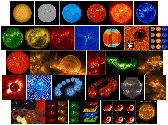
Additional material on the web:
Additional information:
For further background information, please
email Alan Title (title[at]lmsal.com)
or Karel Schrijver (schryver[at]lmsal.com).
Acknowledgements The preparation of the graphic materials for this exhibit was supported by the Lockheed Martin Advanced Technology Center and the NASA Sun-Earth Connection Theme. The images in the exhibit are primarily from the NASA Transition Region and Coronal Explorer (TRACE) and from the Extreme Ultraviolet Imaging Telescope (EIT), the Large Area Solar Coronal Observatory (LASCO), and the Michelson Doppler Imager (MDI) telescopes on the ESA/NASA Solar and Heliospheric Observatory (SOHO). Additional material is from the Japanese-American YOHKOH satellite, from the Big Bear Solar Observatory, the National Solar Observatory at Kitt Peak, the Swedish Solar Observatory, and courtesy of Åke Nordlund (Nordita, Kopenhagen). We are grateful to Zoe Frank and Charlie Little of
Lockheed Martin for their help in preparing these images.